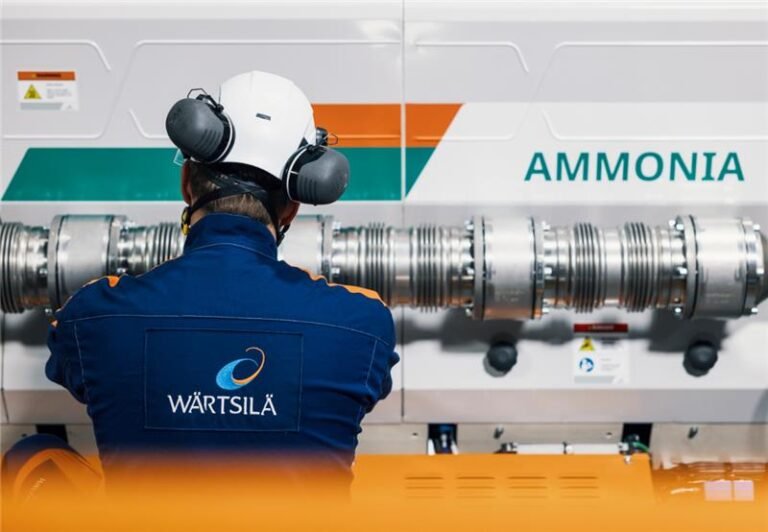Wärtsilä Achieves Significant Reduction in Greenhouse Gas Emissions with Ammonia Engine Solution
Finland-based marine technology major Wärtsilä has achieved a “significant” reduction in greenhouse gas (GHG) emissions with its four-stroke ammonia engine solution, with numbers showing emission levels going down by up to 90%.
According to the company, the Wärtsilä 25 engine has undergone ‘extensive’ testing, the results of which were assessed against the FuelEU Maritime regulation reference and measured on a well-to-wake and take-to-wake basis.
The experiment reportedly showed that a 95% ammonia energy share can cut as much as 90% of GHG emissions compared to diesel engines of a similar design. Wärtsilä has added that this marks an additional 18% improvement on the solution’s emission performance.
The four-stroke ammonia engine, available as part of the Wärtsilä 25 platform, was introduced back in November 2023. It was developed based on the marine technology provider’s experience gained from low-pressure dual-fuel engines running on liquefied natural gas (LNG). At the time when the system was unveiled, Wärtsilä officials shared their expectations for the engine to immediately slash at least 70% of greenhouse gases.
As informed, the recent tests proved that ammonia was a suitable fuel source for the low-pressure Otto cycle concept—the design Wärtsilä used for the engine. Per Stefan Nysjö, Vice President of Power Supply, Wärtsilä Marine, the Otto cycle concept was chosen based on several factors, such as safety, efficiency, and reliability.
Trials conducted on different engine sizes are said to have shown that the efficiency of the low-pressure concept is consistent and equal to that of dual-fuel LNG engines. What is more, ammonia showed to be highly knock-resistant, with combustion capabilities across a ‘wide’ range of settings.
“With decarbonisation front and centre of our company strategy, we have continued to enhance the capabilities of our ammonia engine solution – adding even more safety features and further improving its performance,” Nysjö remarked.
“This is in line with our commitment to ‘continuous improvement’, whereby we continue to develop, test and enhance new and current technologies and solutions that will support the industry in making meaningful reductions in greenhouse gas emissions,” he added.
Specifically, the enhancements made to the Wärtsilä 25 solution’s performance are described as ‘beneficial’ for the entire ammonia system, which consists of an AmmoniaPac fuel gas supply, the Wärtsilä Ammonia Release Mitigation System (WARMS), and the Wärtsilä NOx Reducer (NOR) for ‘optimal’ exhaust after-treatment.
It is understood that alongside future orders, the boosted performance is planned to be fitted onto engines already contracted, with inaugural deliveries due from 2026 onward.
Ammonia has been increasingly seen as a ‘vital’ alternative fuel for the shipping industry. With the global regulations’ course set firm at net zero, numerous industry players, including Wärtsilä, believe that this energy source will play a huge role in enabling shipping’s decarbonization targets set for 2050.
One study performed by Wärtsilä, for instance, showed that existing climate neutrality-oriented solutions, like fuel efficiency measures, can cut down on the maritime transportation industry’s emissions by up to 27%. Green fuels like ammonia, however, could be holding the key to eliminating the remaining 73%, the company’s representatives elaborated.
Challenges and Considerations
That said, utilizing ammonia as a marine fuel does not come without challenges. A February 2024 study from Chalmers University of Technology in Sweden underscored that eutrophication and acidification remain some of the environmental problems that can be traced to the use of this energy source, as well as emissions of laughing gas—a very potent greenhouse gas.
Another disadvantage cited in the study was the production of electro-ammonia, which requires electricity and, thus, represents a very energy-intensive process.
What is more, ammonia is an extremely hazardous compound, with toxicity, flammability, explosions and material incompatibility being the most persistent issues concerning ships powered by the fuel.
It has also been found that, even though the majority of the maritime industry community is willing to work with ammonia, as many as 800,000 workers today need to be upskilled.
Namely, as the Lloyd’s Register Maritime Decarbonisation Hub (The Decarb Hub) and the Mærsk Mc-Kinney Møller Center for Zero Carbon Shipping (MMMCZCS) noted in February this year, current training frameworks under the International Maritime Organization’s (IMO) Convention on Standards of Training, Competency and Watchkeeping for Seafarers Code (STCW) ‘fall short’ of providing seafarers with enough knowledge to handle the ‘unique’ hazards associated with ammonia.

